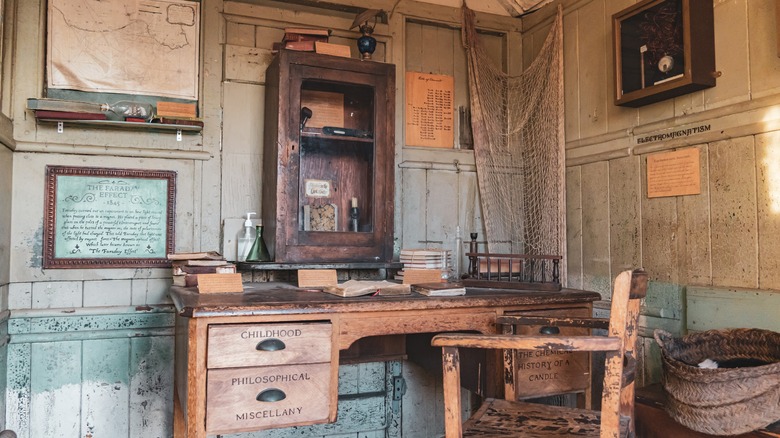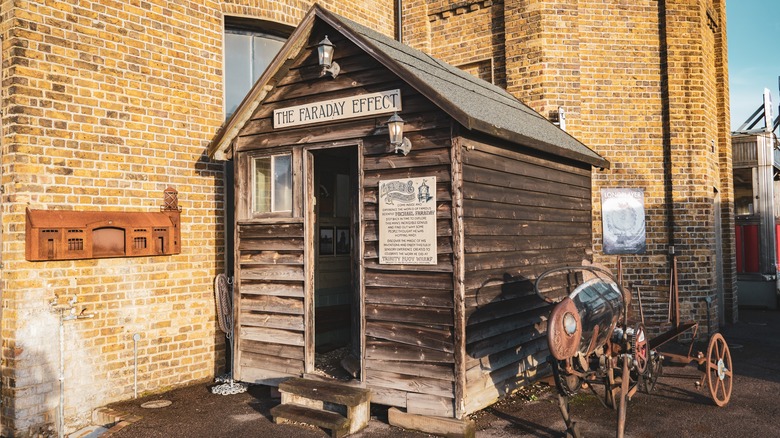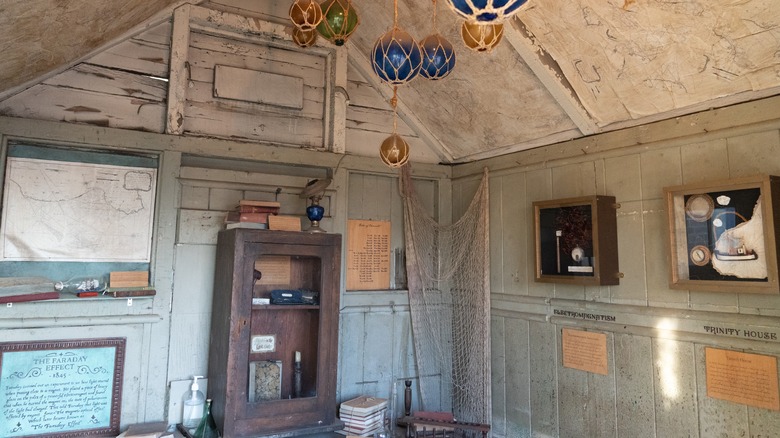Tucked Away In London Is A Secret English Museum That's Considered One Of The Smallest In The World
They say that good things come in small packages: Snowflakes, Belgian truffles, espresso, miniature horses. But who knew that an immersive, educational, and artistic experience could also come micro-sized? Well, that's exactly what The Faraday Effect, an art installation and one of the smallest museums in the world, aims to provide.
This installation may even be smaller than Mmuseumm, New York's oddly thought-provoking exhibit inside an elevator shaft. It's housed in an old garden shed so tiny and non-descript that you might just miss it as you're walking by. You can find it at Trinity Buoy Wharf, an arts and culture hub on the River Thames located in the historical Docklands district of London. This charming mini-museum is dedicated to the life and works of Michael Faraday – the famed Victorian electromagnetist referred to as "the father of electricity." From 1836 until 1865, Faraday was the scientific advisor to Trinity House, which was headquartered on the wharf and was initially established as a guild for mariners in the 1500s.
The wharf used to be the site where buoys and other sea marks were built, repaired, and stored. It hosted several buildings, including the Chain and Buoy Store and the Experimental Lighthouse (the only one remaining in London). Unlike most lighthouses, however, this one was not built for navigating boats along the Thames. Instead, its purpose was to train lighthouse staff. And on the rooftop connecting the store with the lighthouse was the workshop where Faraday conducted his many experiments on electric lighting. One of his most integral discoveries was that of magnetism's effect on light, which became known as the Faraday effect. To this day, the discovery continues to play a crucial role in technological advancements, mainly in the fields of medical imaging, telecommunications, astronomy, and more.
What to expect at The Faraday Effect
The Faraday Effect was the brainchild of Ana Ospina and Cara Flowers, artists and founders of the creative studio Fourth Wall Creations, who were commissioned to set up this installation in 2005. The two painstakingly researched Michael Faraday's 19th-century workspace and recreated it at the wharf. It was originally envisioned as a temporary, site-specific art installation, but it is now a permanent museum that captures a small part of the area's unique history. Even the shed itself, which houses the museum, is part of the wharf's maritime heritage: It is the same shed where dockworkers went to collect their wages, and the chair, cabinet, and desk that remain inside are also vestiges of that 19th-century past.
Upon approaching the building, you'll hear crashing waves and noises typical of a bustling dockyard, along with the buzzing sounds of electrical experiments. This is part of the soundscape designed by the artists to complement the installation. At the entrance, a sign beckons playfully to visitors: "Come inside and experience the world of famous scientist Michael Faraday. Step back in time to explore this man's incredible genius and find out why some people thought he was hopping mad!"
Once inside, you'll find a reimagined replica of Faraday's workspace, along with historic documents, antiques, and found objects. Boxes tacked to the wall provide more insight into some of his experiments. Since it opened to the public, The Faraday Effect has continued to provide a small but profound window into the scientist's brilliant mind and a look into his world-changing breakthroughs.
How to visit The Faraday Effect
The Faraday Effect and other creative sites at Trinity Buoy Wharf are open every day from 7 a.m. until 7 p.m., except on Christmas Day. It can be found next to the lighthouse, and it's free to enter. Due to its tight size and the steps leading into the entrance, the museum is unfortunately not universally accessible. It is ideal for one or two visitors at a time – more than that, and it'll start to get uncomfortable. Note that the installation has undergone some wear and tear, despite multiple refurbishments and updates by the artists. So when you're visiting, don't touch or remove any of the exhibits; leave the space exactly as you found it for others to enjoy.
It's worthwhile to wander around Trinity Buoy Wharf and take in its many additional sites, too. The aforementioned Experimental Lighthouse, completed in 1864, is also free to enter. Here you can listen to the Longplayer, a 1,000-year-long composition that will play until the end of 2999. Stroll through the area and see the funky, vibrant Container City 1 and 2, home to a variety of creative businesses, along with the historic buildings and 19th-century vessels docked in the marina.
You can reach the wharf by public transit: The closest Tube station is Canning Town, while the nearest DLR station is East India. If you're still in need of creative fulfillment, London has certainly got you covered. Take in world-famous art collections at the expansive British Museum, or play around at quirky pop-ups like The FRIENDS™ Experience: The One in London, a fun and immersive exhibit. You can also head to areas like Shoreditch and Camden to find the best street art murals in London.


